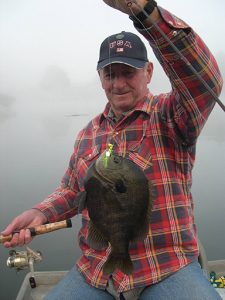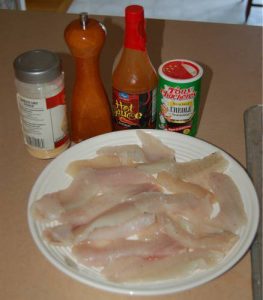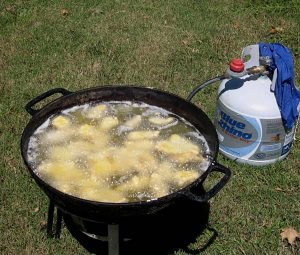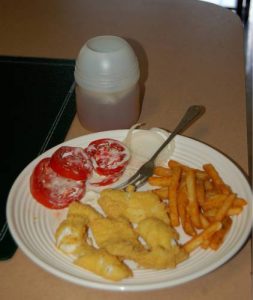The fog lay low and the water steamed as it will do on a cool spring morning. Later, as the sun burned the fog away, we could shed our flannel shirts. At present, we were too busy catching bream bigger than a big hand.
A bream like this will weigh at least a pound, maybe more. It was early and we had over 20 such fish in the cooler.
A fish fry was at hand.
Slowly, we worked around the cypress snags and old timber, casting 1/8-ounce Road Runners with a slow retrieve. We used four-pound line on light or ultra-light spinning rods. Probably, with crickets and a cane pole, we could have caught more. But there is something about an 18-ounce bream on light tackle that grabs me. A big, bull bluegill, pulling a small boat in a circle, is a joy to any fisherman.
Uncle Lester shakes the boat with a solid hook set.
“Good one,” he says, and I can see from the bend in his rod he is not exaggerating. Two-minutes later, I net the fish for him and guess it at almost two pounds.
Down the bank, a bullfrog harrumphs, as they do. He has been sounding off every few minutes and several others have joined him.
I look at Uncle Lester. No need to speak; he reads my mind.
“After supper,” he says, “we’ll let the fish settle, then get the gigs and the lights. I’m thinking frog legs and eggs would make a good breakfast.”
I concur.
An egret stalks in the shallows. A water snake leaves to go somewhere else. On the mud bank is a slick where a gator has been coming and going. In the South, this is a time of plenty for the outdoorsman. The bream are biting, the crappie are starting to spawn, turkeys gobble and the big frogs will hold for a light.
But it doesn’t have to be bluegill-bream or even crappie. There are many fish, nationwide, that provide superb table fare, either filleted or whole. Crappie, bluegill, walleye, bass under a pound, yellow perch…all great. Unfortunately, so many cooks fry them too long and lose much of the flavor and texture.
If your fish are not really big enough to fillet, simply clean them, remove the heads and scale them well. Leave the tails and fins on. I, personally, prefer the fillets, but a whole bream is good and fun to eat. The tails and fins, crispy and golden, are a delicacy.
Try this simple cooking method noted below and see how you like it.
In the Kitchen
You have the fish, filleted or whole, cleaned and well washed and soaked in a light salt water solution for about 10-minutes. Remove and wash. Place in the freezer for just long enough to get well chilled. Remove and pat dry. If it is a whole fish, make light vertical scores from top fin down, about two inches apart, usually two or three per side.
In a large enough bowl, combine one pint of buttermilk and two eggs. Beat well and submerge fish. On top of the fish and buttermilk, sprinkle several drops of your favorite hot sauce. I prefer Louisiana Hot Sauce or Mcilhenny hot sauce. Let soak about 20 minutes.
In a sack, or big bowl, combine yellow corn meal and seasoning. I prefer Tony Chachere Cajun Seasoning and I like Martha White corn meal. Use enough seasoning to color the corn meal. Add freshly chopped and ground black pepper to taste. No salt. If you need them saltier, do that as you remove them from the cooking oil.
In a big skillet or deep fryer, heat enough oil to allow plenty of room. Heat to 375-400 degrees F. When oil is hot, remove fish from milk, shake off excess and shake or dredge in corn meal. Get them well “mealed”. Place fish in hot oil. Do not crowd the cooker. Fry in smaller batches or “drops” and leave plenty of room for the individual pieces to move. This will keep the cooking oil at proper temperature and cook the fish better. When they are golden brown and floating, usually about 90 seconds for fillets, remove and drain. With whole fish, when the tails and fins are crispy and golden, take them out.
Be sure you don’t cook the fish too long. Can’t say this enough.
Serve with a garden salad, French fries, maybe hush puppies or corn bread, sweet or unsweetened tea or a cold one and you have a feast.
But wait. What is a fish fry without something to dip the fish in?
Combine Hellman’s mayonnaise, about ¾-cup, with enough ketchup to color the mixture a deep orange. Shake in enough Worcestershire sauce to give the dip a brown cast and enough hot sauce to give it a bite. Squeeze a little lemon juice on top. You now have a superb dip for the fish.
Hunting Tip:
The smart hunter, providing he has the opportunity, often combines a scouting trip with a fishing trip. If the hunter has permission to hunt the land along a lake shore or river bank, periodically stopping and looking can pay big dividends in the future. Approaching a stand site from the water, by boat or canoe, done correctly, can allow a hunter to reach his stand almost undetected.
In the early spring and summer, while fishing, I often stop and walk the bank. I am looking for three things: Obvious trails, rubs from more than one season and the right trees. When I find two of the three, I record the exact location and either find or make a landmark on the bank where I can park the boat.
What are the right trees? This depends on where you live. Almost anywhere there are whitetail deer, there are oak trees. There are two main varieties of oak — red and white. Usually, the red oak drops its mast first. A week or so later, the white oaks drop. Oak trees in river bottoms or on lake shores may be the first and often only oaks that bear mast. They become feeding magnets for deer. Make a note, go back in September and check them out.
The other trees I look for are fruit trees. Persimmon, crab apple and paw-paw trees are prevalent where I live. It may be different where you are. These trees, when dropping fruit, can be true killer hot spots.
Pick a stand tree, clear or mark a trail, find a secure boat landing spot and be sure you can find it in the dark. Until a few years ago, when age became a factor, 50 percent of my stands were stands I reached by boat. They were on public ground and not one time did I see another deer hunter.





